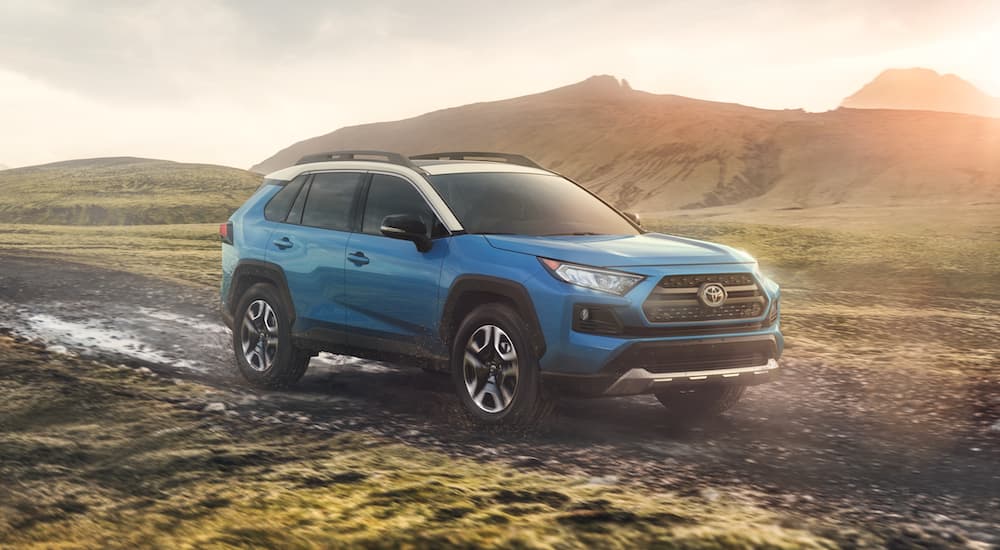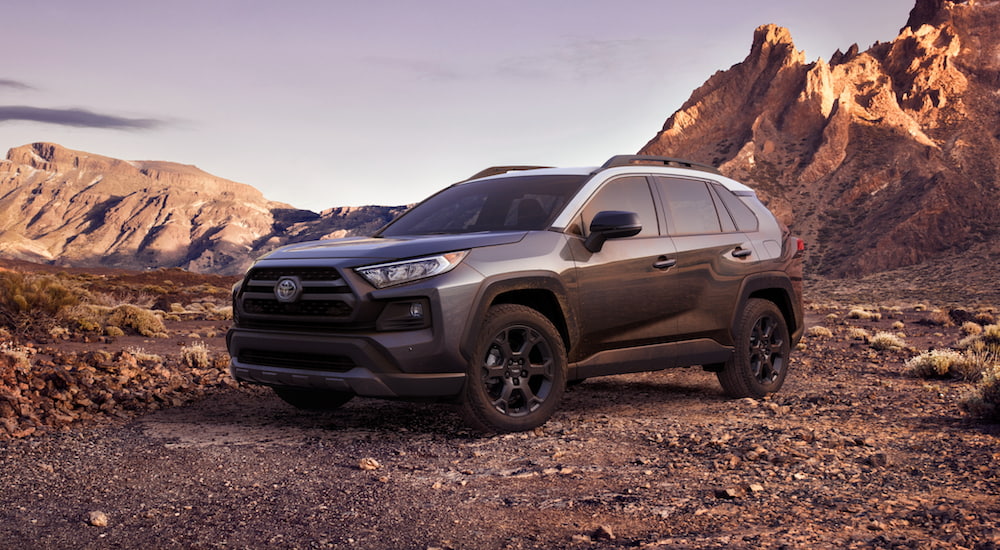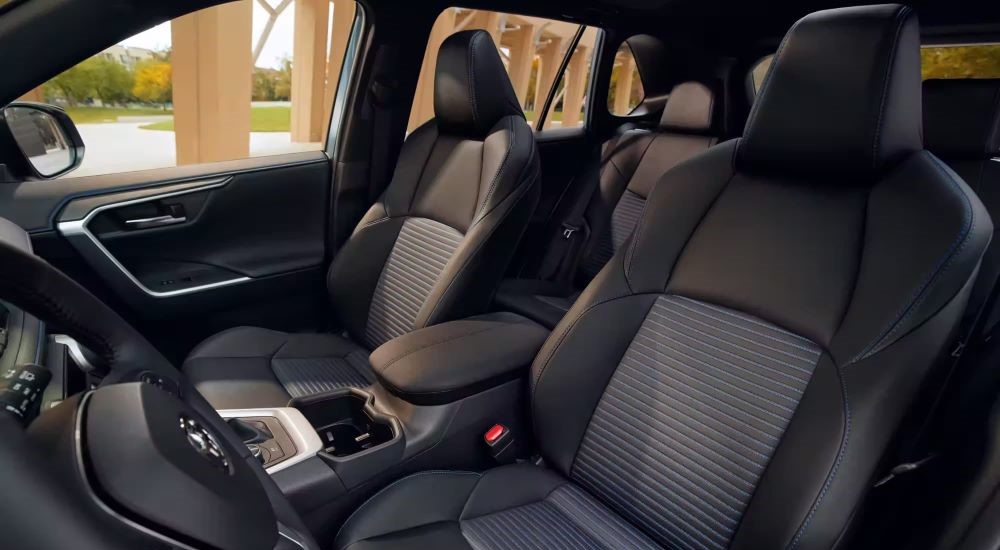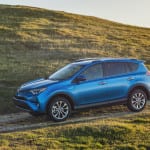Modern vehicles all seem to come equipped with some high-tech safety features. No package is perhaps as complete or adept at protecting passengers as Toyota’s suite of advanced safety features, bundled into what’s known as Toyota Safety Sense (TSS). It was first introduced to the market when it became available on 2016 models across the entire Toyota lineup, including on all versions of the RAV4. Toyota continues to refine and add to its safety suite as new technologies become available. This is a testament to the brand’s commitment to being on the cutting edge of innovation and placing the safety of its passengers at the forefront.
Today, it’s easy to find a used RAV4 for sale that comes equipped with a version of TSS. What isn’t as easy is understanding which features are available for what model year since Toyota is always adding to its safety suite. We’re going to break down the different versions of TSS available on the used RAV4 market so you can get a better understanding of what is available when shopping for a pre-owned SUV.
2016-2018 RAV4: TSS-P
When Toyota initially launched its TSS suite, it came in two varieties: TSS-C and TSS-P. The TSS-C option was made for compact cars and had a more limited range of features than TSS-P, which was intended for larger vehicles like the popular RAV4 SUV. It was introduced as an optional feature in 2016 before being made standard on all 2017 and later RAV4 models, including the hybrid version. TSS-P includes a wide range of features.
Pre-Collision System with Pedestrian Detection (PCS w/PD)
This system in 2016-2018 RAV4 models helps drivers detect obstacles like pedestrians and other vehicles that are in their path. It uses advanced radar and camera technology to sense these obstacles, even if they’re moving, and triggers an alert. It can even automatically step on the brakes for the driver if it senses the driver isn’t reacting fast enough to the potential collision. The Pre-Collision System is especially useful in cities with lots of stop-and-go traffic that might cause someone to get distracted or not realize a jaywalker is crossing the road where they shouldn’t be. People who commute through heavy traffic also find this feature enormously beneficial, as it can be difficult to keep track of everything going on around you when the roads get busy.
Lane Departure Alert with Steering Assist (LDA w/SA)
TSS-P’s Lane Departure Alert feature is used to help drivers stay in their lanes and avoid the dangers of drifting into oncoming or parallel traffic. The system uses cameras located near the rear-view mirror facing outward over the hood. They view and monitor road markings to ensure the vehicle is staying safely in its lane. When the system detects that the driver is drifting, it produces a noise and lights up a warning on the dash. In most cases, the driver corrects the error; if not, the Steering Assist feature is activated.
Steering Assist kicks in when no corrective action to move back within the lane happens. It gently provides steering inputs to guide the vehicle back into position. It isn’t powerful enough to override the driver entirely, so if the seeming error is intentional, perhaps to avoid debris on the road, the vehicle doesn’t steer into a messy situation. Mostly, this feature is used to ensure tired or distracted drivers don’t let a momentary lapse become a big problem.
Auto High Beams (AHB)
If you’re driving at a speed exceeding 20 mph in the dark, this useful feature automatically turns on the high beams to help you see better. It also senses the light from approaching cars’ headlights and the taillights of vehicles you’re following. This lets it toggle between high and low beams in response to conditions so that you don’t unnecessarily beam your brights into oncoming traffic and make it hard for other drivers to see. This feature helps improve visibility for drivers in the RAV4 while also taking into account the potential glare being created.
Dynamic Radar Cruise Control (DRCC)
Dynamic Radar Cruise Control uses radar and cameras to keep the vehicle driving at a speed that is preselected by the driver. It’s designed to be used at speeds greater than 25 mph and is typically used on highways during longer journeys. Unlike standard cruise control, which has been around for years, it takes the distance to the vehicle ahead into account and will automatically slow down if needed so a collision doesn’t occur. When that car pulls away, either speeding up or switching lanes, DRCC will bring your vehicle back up to its preselected speed. Drivers can also choose how closely they want to follow other cars. This feature adds metaphorical bumpers to standard cruise control so that accidents are less likely to occur.
2019-2022 RAV4: TSS 2.0
In 2019, Toyota rolled out its next generation of the Toyota Safety Sense suite for the redesigned fifth-generation RAV4. Instead of coming equipped with TSS-P, RAV4s during this time now had TSS 2.0. In addition to tweaking the existing features to optimize safety, Toyota also added two additional features and significantly enhanced its Dynamic Radar Cruise Control feature.
Full-Speed Range Dynamic Radar Cruise Control (DRCC)
The “full speed range” version of the existing Dynamic Radar Cruise Control greatly increases the situations in which this feature can be used. Instead of mainly being useful at highway speeds, the upgraded version works at all speeds and can safely bring your RAV4 to a complete stop if needed. This means the DRCC feature can be used during stop-and-go slowdowns on the road.
Lane Tracing Assist (LTA)
This new feature uses the same technology as Lane Departure Alert but helps drivers stay centered in their lane when DRCC is active. It can nudge the RAV4 back into a central position when it detects a shift. This additional feature in the TSS 2.0 suite is especially useful for driving in high-speed or heavy-traffic environments when drifting can be particularly dangerous.
Road Sign Assist (RSA)
Road Sign Assist (RSA) is an entirely new feature for TSS 2.0. It reads street signs such as stop signs, yield signs, and speed limit signs and displays an icon of them in the RAV4 driver display! This futuristic piece of technology helps drivers avoid missing an important marker, keeping them informed and making their driving experiences safer.
2023 RAV4: TSS 2.5 and TSS 2.5+
In 2023, Toyota launched its next iteration of its TSS suite, calling it TSS 2.5. Unlike the prior rollout, this launch features higher-resolution cameras and millimeter-wave radar enhancements that improve the functionality of the existing features instead of adding new ones. For instance, TSS 2.5 adds intersection support and emergency steering assist to the existing Pre-Collision System.
An even more upgraded 2.5+ version of the TSS suite of safety features became available on the RAV4 Prime in 2023. TSS 2.5+ adds bicycle detection to the Pre-Collision System and something called “curve speed management” to Full-Speed Range Dynamic Radar Cruise Control. Essentially, it uses the RAV4’s camera and yaw sensors to visualize upcoming curves in the road and reduce speed accordingly. When the curve has been completed, the regular preset speed is resumed.
Toyota Safety Sense: Making Every Drive Safer
Every RAV4 produced for the 2017 model year and later will come standard with some version of Toyota Safety Sense. However, the precise version has changed a few times over the years, and it’s important to keep that in mind. People looking for a used RAV4 for sale will do well to filter their searches specifically to these years to ensure they’re getting the most safety features included in their used car.






